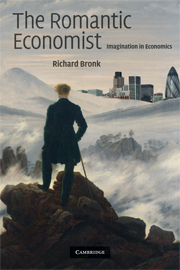Book contents
- Frontmatter
- Dedication
- Epigraph
- Contents
- Preface
- Acknowledgements
- 1 Preface to The Romantic Economist
- PART I THE PRELUDE: THE ROMANTIC ECONOMIST AND THE HISTORY OF IDEAS
- PART II Fragments of Unity: Romantic Economics in Practice
- 5 Using organic metaphors in economics
- 6 Economics and the nation state
- 7 Incommensurable values
- 8 Imagination and creativity in markets
- 9 Homo romanticus and other homines
- 10 Imagination and perspective in economics
- 11 The Romantic Economist: conclusion
- Notes
- Bibliography
- Index
9 - Homo romanticus and other homines
Published online by Cambridge University Press: 05 March 2015
- Frontmatter
- Dedication
- Epigraph
- Contents
- Preface
- Acknowledgements
- 1 Preface to The Romantic Economist
- PART I THE PRELUDE: THE ROMANTIC ECONOMIST AND THE HISTORY OF IDEAS
- PART II Fragments of Unity: Romantic Economics in Practice
- 5 Using organic metaphors in economics
- 6 Economics and the nation state
- 7 Incommensurable values
- 8 Imagination and creativity in markets
- 9 Homo romanticus and other homines
- 10 Imagination and perspective in economics
- 11 The Romantic Economist: conclusion
- Notes
- Bibliography
- Index
Summary
From the perspective of the social sciences, two species of human being bestride the earth — homo economicus (the rational maximiser of utility) and homo sociologicus (a social chameleon whose character is determined by its cultural environment). This chapter documents the characteristics of a third equally important denizen of the social world — homo romanticus (the self-creating, sentimental, sympathetic and imaginative social animal). It also argues that these three species are rarely found in their pure form. Instead, of course, we usually find homo sapiens — endowed with characteristics from all three purebred species in varying proportions to suit different environments. This poses considerable challenges for the social scientist. How are we supposed to decide when (and how far) each set of characteristics is likely to be dominant, and build our explanatory models accordingly? And how far are hybrid models of motivation possible or desirable? This chapter outlines answers to these questions, and indicates ways in which economists can meet the challenges of analysing markets and societies full of individuals who are socially constructed and creative as well as rational.
HOMO ECONOMICUS THROUGH THICK AND THIN
Homo economicus evolved as a discrete analytical species dominating economic discourse from Benthamite utilitarian stock, and was first identified with precision by John Stuart Mill.
- Type
- Chapter
- Information
- The Romantic EconomistImagination in Economics, pp. 225 - 255Publisher: Cambridge University PressPrint publication year: 2009

